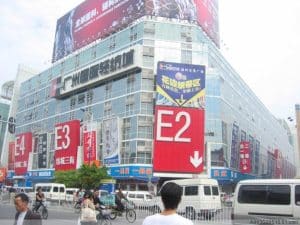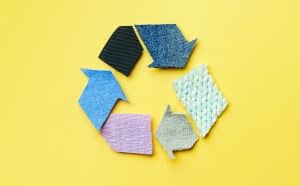Recycled polyester fabric has become increasingly popular in the textile industry due to its eco-friendly properties and versatile applications. In this comprehensive guide, we’ll delve into the world of recycled polyester to help you understand what it is, its advantages and disadvantages, and how it’s transforming the textile industry.

Table of Contents
- What is Recycled Polyester Fabric?
- The Manufacturing Process
- Advantages of Recycled Polyester
- Disadvantages of Recycled Polyester
- Applications of Recycled Polyester Fabric
- Sustainable Brands Embracing Recycled Polyester
What is Recycled Polyester Fabric?
Recycled polyester, also known as rPET, is a sustainable fabric that’s made by melting down existing polyester products, like plastic bottles, and spinning them into new fibers. This innovative process helps reduce waste, conserve energy, and lower greenhouse gas emissions compared to virgin polyester production.
The Manufacturing Process
- Collection: The process begins with the collection of used polyester materials, such as plastic bottles and textiles.
- Cleaning and Sorting: Collected materials are then cleaned and sorted, removing any impurities and separating different types of plastic.
- Shredding: The materials are shredded into small flakes, which are then melted down.
- Extrusion: The molten polyester is extruded through a spinneret, forming long, thin fibers.
- Spinning: The fibers are cooled and then spun into yarn, which can be woven or knitted into fabric.
Advantages of Recycled Polyester
- Eco-friendly: Recycled polyester reduces waste and conserves natural resources, helping to minimize the environmental impact of the textile industry.
- Energy-efficient: The production process of recycled polyester uses less energy and water than virgin polyester manufacturing.
- Durability: Recycled polyester fabric is long-lasting, resistant to wear and tear, and maintains its shape over time.
- Versatility: This fabric can be used in various applications, from clothing and accessories to home furnishings and industrial products.
- Easy care: Recycled polyester is low-maintenance, machine washable, and quick-drying.
Disadvantages of Recycled Polyester
- Limited recycling capacity: The recycling process can only be repeated a finite number of times before the fibers degrade, which may lead to downcycling.
- Microfiber pollution: Like virgin polyester, recycled polyester can release microplastics during washing, contributing to water pollution.
- Chemical-intensive: Some recycling methods may rely on chemical processes, which can be harmful to the environment and human health.
Applications of Recycled Polyester Fabric
Recycled polyester is widely used in a variety of products, including:
- Clothing and activewear
- Swimwear
- Bags and accessories
- Home furnishings (e.g., upholstery, curtains, and bedding)
- Industrial materials (e.g., insulation, automotive components, and geo-textiles)
Sustainable Brands Embracing Recycled Polyester
Many fashion and textile companies are adopting recycled polyester to create more sustainable products. Some notable brands include:
- Patagonia
- Adidas
- Eileen Fisher
- H&M Conscious Collection
- Stella McCartney
Recycled polyester fabric offers an eco-friendly and versatile alternative to virgin polyester, with numerous advantages in terms of sustainability and energy efficiency. However, it’s essential to be aware of the potential disadvantages, such as microfiber pollution and the limited recycling capacity of the material. As consumers become more conscious of their environmental impact, the demand for recycled polyester products will likely continue to grow, encouraging further innovation and sustainable practices in the textile industry.



